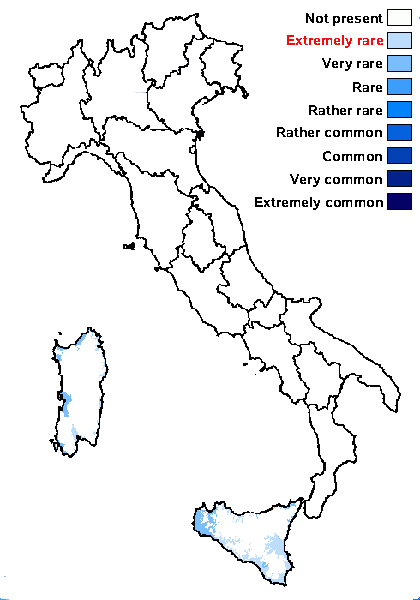Rinodina cretica H. Mayrhofer
J. Hattori Bot. Lab., 55: 402, 1984.
Synonyms:
Distribution: C - Sar. S - Si (Nascimbene & al. 2021).
Description: Thallus crustose, endosubstratic, usually poorly evident. Apothecia cryptolecanorine to lecideine, immersed in pits in the rock, up to 0.5 mm across, with a flat, black but grey-pruinose disc and a thin, black proper margin. Proper exciple dark brown in outer part, colourless within, containing some algal cells in lower part at least when young; epithecium brown, K-; hymenium colourless, 70-80 µm high; paraphyses c. 1.5 µm thick at mid-level, the apical cells 3-5 µm wide, with a dark brown cap; hypothecium colourless, up to 100 µm high. Asci 8-spored, clavate, the K/I+ blue tholus penetrated by a faintly amyloid apical cushion with parallel or diverging flanks, the wall K/I-, surrounded by a K/I+ blue outer layer, Lecanora-type. Ascospores 1-septate, brown, broadly ellipsoid, 15-21 x 11-14 µm, Bicincta-type, the outer wall thickened at septum and apices when young, the lumina soon rounded, with a weakly pigmented band around each cell, the wall with a finely verrucose ornamentation, the ontogeny of type A (apical wall thickening after septum formation). Photobiont chlorococcoid. Spot tests: K-, C-, KC-, P-, UV-. Chemistry: without lichen substances. Note: a Mediterranean calcicolous species, probably somehow more widespread in Southern Italy.
Growth form: Crustose endolithic
Substrata: rocks
Photobiont: green algae other than Trentepohlia
Reproductive strategy: mainly sexual
Commonnes-rarity: (info)
Alpine belt: absent
Subalpine belt: absent
Oromediterranean belt: absent
Montane belt: absent
Submediterranean belt: absent
Padanian area: absent
Humid submediterranean belt: absent
Humid mediterranean belt: very rare
Dry mediterranean belt: extremely rare

Predictive model
Growth form: Crustose endolithic
Substrata: rocks
Photobiont: green algae other than Trentepohlia
Reproductive strategy: mainly sexual
Commonnes-rarity: (info)
Alpine belt: absent
Subalpine belt: absent
Oromediterranean belt: absent
Montane belt: absent
Submediterranean belt: absent
Padanian area: absent
Humid submediterranean belt: absent
Humid mediterranean belt: very rare
Dry mediterranean belt: extremely rare

Predictive model
 INDEX FUNGORUM
INDEX FUNGORUM
 GBIF
GBIF

